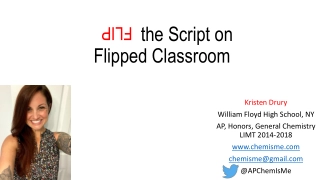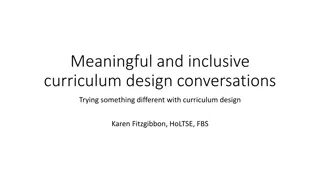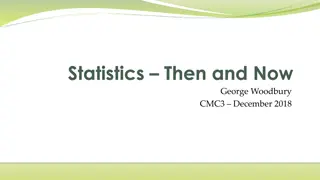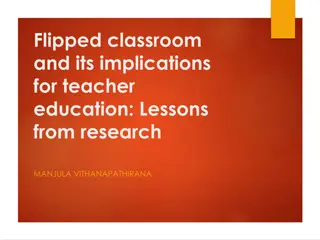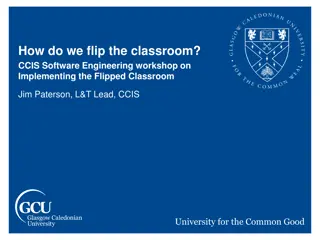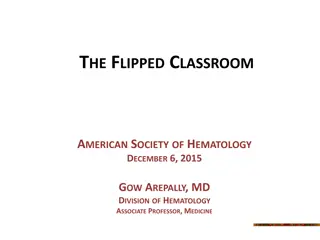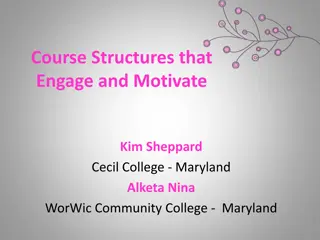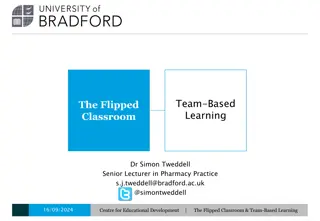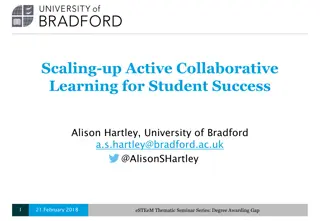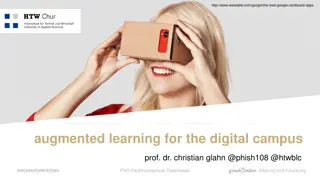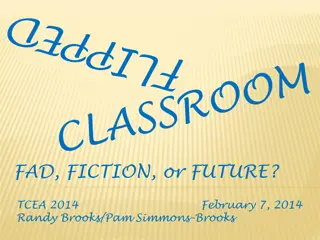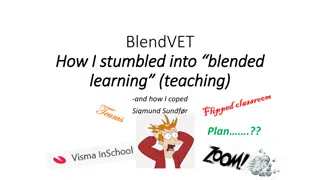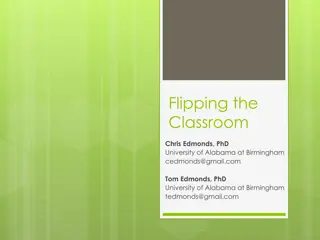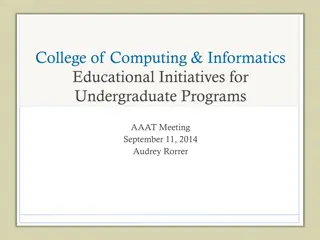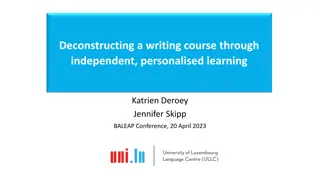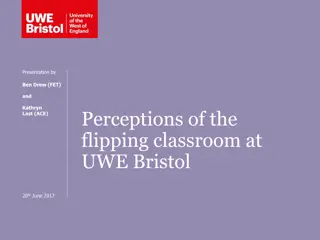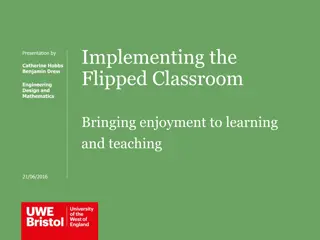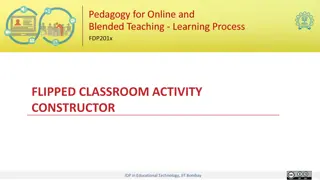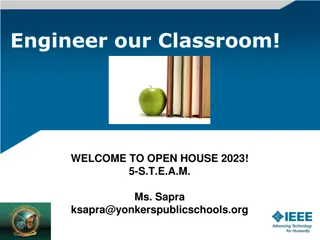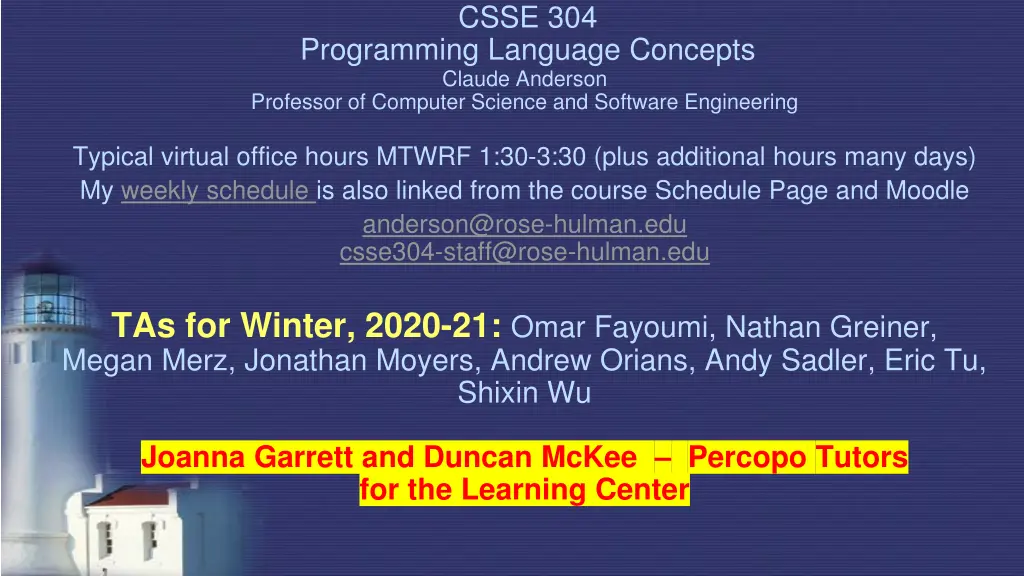
Computer Science and Programming Language Concepts with Professor Anderson
Join Professor Claude Anderson in exploring programming language concepts and computer science topics. Get access to virtual office hours, TA support, and engage in interactive sessions. Dive into Scheme-athon, review material, and participate in live demos and group work. Enhance your understanding of forms, syntax, and procedures in Scheme programming language.
Download Presentation

Please find below an Image/Link to download the presentation.
The content on the website is provided AS IS for your information and personal use only. It may not be sold, licensed, or shared on other websites without obtaining consent from the author. If you encounter any issues during the download, it is possible that the publisher has removed the file from their server.
You are allowed to download the files provided on this website for personal or commercial use, subject to the condition that they are used lawfully. All files are the property of their respective owners.
The content on the website is provided AS IS for your information and personal use only. It may not be sold, licensed, or shared on other websites without obtaining consent from the author.
E N D
Presentation Transcript
CSSE 304 Programming Language Concepts Claude Anderson Professor of Computer Science and Software Engineering Typical virtual office hours MTWRF 1:30-3:30 (plus additional hours many days) My weekly schedule is also linked from the course Schedule Page and Moodle anderson@rose-hulman.edu csse304-staff@rose-hulman.edu TAs for Winter, 2020-21: Omar Fayoumi, Nathan Greiner, Megan Merz, Jonathan Moyers, Andrew Orians, Andy Sadler, Eric Tu, Shixin Wu Joanna Garrett and Duncan McKee Percopo Tutors for the Learning Center
TAs TA lab hours begin today. A bit trickier when everything is online. M-F 2:00-4:50 and 7:00-11:00. Sunday 4:00-11:00 Please give me feedback on how the assistants are doing. There is an anonymous feedback survey on Moodle. And another one for feedback on the course itself.
Scheme-athon begins! First 2.5 weeks of the course If you are a member of NPS, plan to suspend your membership for this term!
Your questions Elementary Scheme (things that were covered in the five intro videos). Save more advanced questions for later, or ask on Piazza Course policies and procedures Finding things on the web
This is from The Scheme Programming Language Summary of Forms What s the difference between procedure and syntax ?
Review a few things from the videos Draw pictures and show what is printed
Scheme overview at end of this slide set After the next Live Demo slide, there are 8 more slides that give a high-level overview of Scheme. I don t usually go over these slides in class, but I suggest that you read through them quickly when you get time. I ll be happy to answer any questions that you may have on these at the beginning of tomorrow s class.
Live demo and group work We ll go a little bit farther with Scheme After the live demo I will split you up into breakout rooms. Work on some aspect of HW1 in the time that you have. Someone who has Scheme installed should be the driver. Driver can share code (by email) with others at the end of class time. It is possible (because I am still not an expert on managing an online class session) that we won t get to the group work.
Overview of Scheme The next six slides give an overview of the Scheme language. Good stuff! Pretty self-explanatory. Duplicated on your class notes hand-out. Read it before tomorrow s class; if you have questions, ask them in tomorrow s class. Now we are going to jump right into more Scheme exploration.
Overview of Scheme 1 Invented in 1975 by Guy Steele and Gerald Sussman at MIT. Syntax similar to LISP, semantics more like the Algol family (Pascal, Ada, C, Java ) Expression-oriented and interactive (like Maple, Python, MatLab).
Overview of Scheme 2 Data and programs have the same syntax http://xkcd.com/859/ (Linked) lists are a fundamental, built-in data type Not statically typed (similar to Python, Maple, PHP, JavaScript; unlike C and Java) Everything is in prefix form: (+ a b) instead of a + b Argument passing is similar to Java primitives are passed to procedures by value others (lists, vectors*, etc.): references passed by value. * vector is Scheme's array type. Similar to Java arrays
Overview of Scheme 3 Symbols can be data Somewhat similar to Maple Procedures are (first-class) data Can pass them as arguments to other procedures A procedure can create and return another procedure Can store a procedure in a data structure (such as a list or array of procedures) More on this soon! Minimal procedure overloading.
Overview of Scheme 4 Java s newoperator has no Scheme equivalent Instead there are specific procedures for creating objects of each type: cons creates a pair (pair is Scheme's main data type) vector creates a vector (like a C or Java array) list creates a (proper) list of its arguments string creates a string from zero or more characters lambda (which is not a procedure*) creates a procedure define-syntax (also not a procedure) creates new syntax that extends the Scheme language itself *In the Summary of Forms at the end of TSPL, "not a procedure" is denoted by "syntax" http://scheme.com/tspl4/summary.html
Scheme data types and constants Numbers 6 -12 14283917850923094767626456 5/17 (+ 1/3 1/6) (max 5 7 3) 7.05 3.5e7 (+ 2e3 3e2) TSPL section 6.3 lists the available operations on numbers. Boolean (note that if returns a value) #t #f (if (< a b) a (+ b 1)) String This is a String (string-length Hello )
Data types and constants 2 Character #\A #\newline (char->integer #\A) Symbol (quote hello) hello Vector (like an array in other languages) #(1 3 2) (make-vector 5 7) (vector-ref v 4) Empty List ( ) Pair (3 . 5) List of three elements: (3 5 7) Improper list (3 5 7 . 8) List of lists: ((2 4) (5 6 7) (8) ()) Draw pictures
Live demo Scheme source file-name extensions .ss , .scm I ll use .ss I'll demonstrate SWL and the Emacs editor. In-class coding will be in the Live-in-class folder, linked from Resources column of Day 1 of the schedule page. We will continue this demo/discussion tomorrow. You can follow along on your computer, or you can just watch, think, and ask questions.

